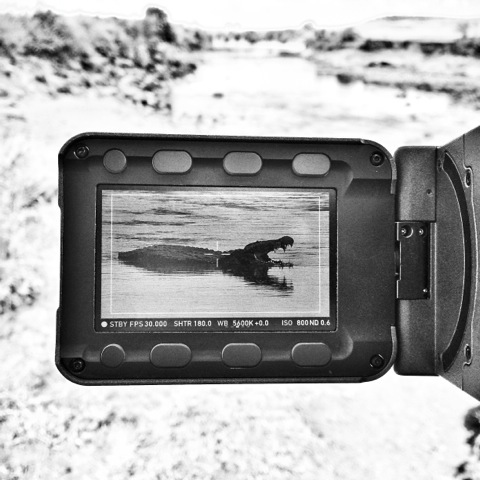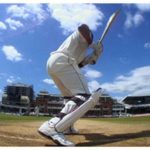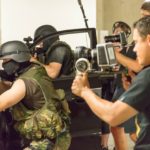
Wildlife Wish List
Posted on Aug 18, 2014 by Alex Fice
Susan Gibson on the Masai Mara in Kenya with the Arri Amira and Canon lens.
Wildlife filmmakers Chadden Hunter and Susan Gibson are currently shooting the new mega series One Planet. Looking for the best gear to make it with is just one element but maybe one of the most important .
“One of the challenges that wildlife has is that its very hard to find brand new stories. Whereas even fifteen years ago you could just blow people away as they’d never seen for instance this part of Peru or the Antarctic ice cap or deep sea oceans. Obviously now I think audiences are so savvy and worldly and with the advent of things like YouTube it’s really hard for us to blow people away with animals they haven’t seen before somewhere.” Chadden Hunter is a producer/director of the BBC’s One Planet which is shooting now all over the world. The public’s expectations of the new series is weighing heavy as he tries to conjure up new visual treats. “We debate about whether we should go back to more familiar animals and shoot them in a much more cinematic style, or to find those stories that haven’t been done and still shoot them traditionally on the end of a long lens. I think it is striking a balance.
“What I don’t want to be doing is filming Penguins and Meerkats for the rest of my career just because I can walk through them with a Steadicam.”
 A couple of ‘filming birds’ – Susan Gibson and Sophie Darlington.
A couple of ‘filming birds’ – Susan Gibson and Sophie Darlington.
One way of finding new ways to shoot is to use the latest equipment including the latest camera from Arri, the Amira. “I was a big fan of the Arri Alexa from a series called Wild Arabia. It happened that it was the same camera operator that was coming on the new series, Sue Gibson. She had used the Alexa and was a big fan of it. For the kind of things we wanted to do on the new series she mentioned that the ability to switch between the frame rates quickly and the dynamic range and the decrease form factor of the camera would really work for wildlife. It was more from the camera operators push really and for me as a producer/director it is so important to have a happy camera operator.
“Usually on these high-end wildlife series we talk to the operators about their preferred camera systems, what they’re comfortable with and what the needs of that shoot are. As we went forward there were a number of reasons why it all made sense. It was mostly from Sue’s operator experience that we were able to get our hands on the Amira as early as we could. The obvious good things are the frame rates, the size and the weight were very big issues. Any grams we can shave off in the field can really add up over a month lugging it around. We knew we weren’t going backwards on sensor technology with the Amira. The Alexa was a massive step-up for us on the Wild Arabia series so we guessed the Amira would be just as good.
“One thing I really wanted to do was to shoot in to the sun and that’s something we were never able to do with our Panasonic Varicams, we just didn’t have the dynamic range. I wanted to be making a film about the deserts and the heat and to have say Bedouin Nomads in the frame but with the sun also in the frame, this was where I was looking for the highest dynamic range I could get. Then moving on to this series One Planet, basically Planet Earth 2, again it’s very much about habitat. Each of the series is broken down in to a global habitat. We’re filming the grasslands episode, this was the first shoot for that episode. I knew I wanted really dynamic weather, we wanted thunderstorms as well as back-lit animals. That Arri look is something I’d already fallen in love with.
 Croc on the Amira’s monitor
Croc on the Amira’s monitor
“We had early apprehensions about early models. I think it’s fair to say that there is a bit of ‘pushing it out of the door’ to get the last testing done by people in the field but the nice thing about Arri is that they’ll do that a bit but they will still give you a more finished camera than some of the other manufacturers that we work with.
“We had other cameras out there, we were using the Red Carbon Dragon and a RED Epic which was almost considered back-up. So to have three highly spec’d high end cameras was great and we were also testing sliders, motion controlled time-lapse rigs and MōVIs. The first episode out the door is very kit heavy because we’re really playing around with a lot of stuff that is new to the market and trying to put it through it’s paces to see which products are going to stand out so we can take it back to the team and say these things are really going to help One Planet for the next two years.
“The MōVI is a wonderful tool and does get you some wonderful shots but it takes more effort and attention to get it ‘singing’ than you realise from just watching a promo reel. It has its limitations – moving the camera now in wildlife is a massive part of the look we’re trying to achieve and there are certain things that a Steadicam does that a MōVI just can’t do. There are things that a CineFlex can do whether mounted on a helicopter or a truck that a MōVI can’t. It’s added incrementally to our shooting vocabulary, I wouldn’t call it a revolution yet but it is a useful new tool and there is a nice, organic look to the shots we can get out of it. It just takes a bit of effort to get those.”
“Moving the camera now in wildlife is a massive part of the look we’re trying to achieve and there are certain things that a Steadicam does that a MoVI just can’t do.”
Chadden Hunter, Producer / Director.
Susan Gibson, “We went to IBC and saw the Amira there and then saw it at another show in London. We got speaking to Milan at Arri, we knew that the BBC Natural History Unit had done this before as in talking to certain camera makes and asking to test out new cameras – wildlife doesn’t always get the new stuff. I emailed Milan and Chadden did the same, Milan thought it was a good idea to get the camera out to get fantastic images. For me it seemed like the nearest thing really to a Varicam, but the Varicam is fading out as people are wanting 2k and 4k.
“I was interested in using it as I’ve used the Alexa before and really loved the image quality and was interested in looking at something that was a little bit more portable and had the ENG lens compatibility as they are the lenses that we often use, the HJ18s and the 40s are the ‘go to’ lenses for wildlife really.
“In practice the Amira had the same great image quality, same ease of use. They are such simple cameras to use which is one of the reasons I wanted to try it out. When you’re out in the field you can do without any technical problems if you’re in the middle of nowhere. Kenya’s a bit different because you’re not in the middle of the sticks. But it performed really well, it was great to be able to play it back so easily with the ProRes Quicktime files on your Mac so you can check everything when you get back at the end of the day or even in-camera.
“The ability to switch frame rates really easily was a godsend, I know the REDs can do that too but they do seem to be very loud as soon as you start switching to different frame rates. The fan is just ridiculous and with wildlife sometimes it’s a bit too loud. It’s not so much a problem in the Mara when you’re dealing with Apex predators as lions are so used to the sound of trucks but I can see in other situations where a quiet camera is better. With the Amira I only noticed when you turned to 100 fps and above that the fan slightly kicked in a bit more but it was negligible. I don’t think the fan ever kicked in because of the temperature if you see what I mean, it was only when it was going up to different frame rates but even then it was pretty quiet. Also the built-in NDs were pretty helpful, like the Varicam because not having to be in front of the lens changing filters when you’re trying to film an animal is obviously really useful.
“Wildlife gives a warm glow, it’s one of those feel good genres even though we’re a small market. I think it’s important for manufacturers to be involved in high-end wildlife ”
Chadden Hunter, Producer / Director.
“The ergonomics are great but there are certain things I would change like if I could have certain buttons in different positions. When you’re filming wild life time is of the essence and to get that shot, to have your most used customisable buttons as near to the lens as possible is most useful. So when your hand is travelling away from the lens you’re not knocking it too much. Arri has got some customisable buttons on the viewfinder which is quite a distance for your hand to travel if you’re trying to check for false colour or something like that. Pre-roll is something that we definitely needed as wildlife operators and we didn’t have it on the version we had but with the next firmware upgrade we have been assured that we’ll get it. I think the RED Epic and the Dragon can do up to 30 secs pre-roll which is a little overkill but is only available a certain frame rates. With the Varicam I think the maximum was about eight seconds and I don’t think you need anymore than that. So once these certain things have been upgraded it is the camera I would ask for.
“As I said my lens of choice if either the Canon 18 or 40, perhaps the 18 because of how lightweight it is. We did have the Canon 30-300 cine lens with us which Sophie (Darlington) used on the RED Epic and Dragon. I used it on the Amira as well but it’s not the easiest lens to wield, it’s got a lovely image but the focus goes around almost 360 so when you’re trying to follow an animal it’s not the easiest.”
Wildlife filmmaking came from the history of documentary where you were being given a lecture. Planet Earth was a bit of a tipping point for the audience as it really moved in to entertainment. Pressure has been with the programme makers ever since. Chadden Hunter: “So now certainly for the high-end wildlife we are always looking to shoot it cinematically, we’ve really embraced that shallow depth of field look, the larger sensor cameras and even using Prime cine lenses. It’s all wonderful for the look of it and creatively it’s stretching us and is really satisfying but each one of those cinematic looks and techniques has all sorts of baggage that comes with it. We’re just finding our feet with it if we go for that shallow depth of field focus. For our camera operator to try and keep a Cheetah hunt in focus from start to finish is ten times more difficult and it was already a huge task. So do you want to watch a Cheetah hunt that goes out of focus half way through just because you’ve got shallow depth of field with a cinematic lens on? Also the reach on the lenses is a major headache for us now because with the larger sensors of course you need larger glass to cover the sensor and so the reach that we normally need is staggering. We could be filming a Snow Leopard from about 1,000 metres away. On a smaller sensored camera like the old 2/3rd inch we shot Planet Earth with, that was much easier and could be smaller and lighter. Now the move to UHD sensor size can be an absolute nightmare. To film that same Snow Leopard a lens that might be 20kgs and a metre long, even if they ever made it.
“As the kit’s got more and more complicated we don’t have more resources if we’re out in the middle of the desert or the middle of the rainforest so I think we have this kind of two steps forward and one step back relationship with our kit, a kind of tortured evolution. “We get excited and want to try the things that push the creative boundaries but then we take them out in the field and we very quickly learn what their limitations are and often we come back pulling our hair out as we missed the shot or we didn’t get that key behaviour because the camera system was too modular or we couldn’t look at the right codec or you couldn’t check the focus correctly.
“What drew us to the Amira was that they’d actually focussed a lot of their attention on making a field rugged documentary camera. They haven’t chased that UHD sensor, they’ve kept some of the functionality quite minimalist, it’s a single unit camera. A lot of those things are attractive to us because anytime you can limit the variables in the field the better.
“Judging images now is really tough for us. Just to have monitors of the resolution in the field that you can judge your focus on is tough. You’re talking about a whole new league of workflow systems and of course our budgets don’t really recognise that. We do try and embrace new kit and we certainly work out limitations pretty quickly and then it’s back to drawing board.”








